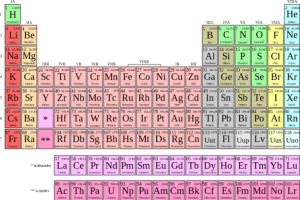Playlist
Show Playlist
Hide Playlist
Ionic Bonds – How Atoms Come Together to Form a Molecule
-
Slides 03 AtomsFormsMolecules CellBiology.pdf
-
Reference List Molecular and Cell Biology.pdf
-
Download Lecture Overview
00:00 So now that we've explored covalent bonds, the very strongest of biological bonds let's take a look at ionic bonds. Common table salt or sodium chloride is a result of a formation of ionic bonds. Ionic bonds result from first, creating an ion by stealing an electron from one and then the resulting charge of a positive and negative sticking together. So they are less strong than a covalent bond. That's still fairly stable. I think of this as an example of, say that having a full electron shell is like having all of the clothes on that you need, eight electrons. 00:41 And having not so full electron shell is sort of like that you would want to have another item of clothing on. Say I'd like to put my jacket on. So, in this case we have sodium which actually has one valence electron. It could easily drop that valence electrons they had and be very happy with a regular set of clothes. Or it could gain seven more electrons which is particularly difficult. 01:10 So in this case, it's actually more willing to give up one electron. So now, let's take a look at chlorine. It's the perfect pairing for sodium. It has seven valence electron and space to gain one. 01:28 Again, it wants to be fully clothed. So it's going to run on over to sodium. It's going to grab the extra electron on the outside and put in on itself. Now sodium is quite angry. And so sodium is going to run after chlorine and try to get its item of clothing back. Say its jacket. 01:49 Because sodium is chasing down chloride, they're going to stick together. So the positive charge of sodium and the negative charge of chlorine lends itself to them, sticking together and forming a crystalline structure. So when chlorine steals the electron from sodium, it satisfied the octet rule and also left sodium satisfied because it also has a full valence shell. Both of these molecules are now stable when they are in association. So when we stir our sodium chloride into a glass of water, the sodiums and the chlorides are literally falling apart because of the ionic charges. And shortly, we'll start to understand how water dissociates and polarity of different molecules such that sodium and chloride can actually become dissolved in water.
About the Lecture
The lecture Ionic Bonds – How Atoms Come Together to Form a Molecule by Georgina Cornwall, PhD is from the course Introduction to Cell Biology.
Included Quiz Questions
Which of the following best describes ionic bond formation?
- The complete transfer of electrons from one atom to another to satisfy the octet rule
- The sharing of a pair of electrons between participating atoms to satisfy the octet rule
- The formation of a hydrogen bond between an oxygen atom and a hydrogen atom to satisfy the octet rule
- The development of a partial dipole moment in a molecule to satisfy the octet rule
- The formation of a hydrogen bond between an electronegative atom and a hydrogen atom to satisfy the octet rule
What happens to NaCl crystals upon dissolving in water?
- NaCl crystals will ionize and be surrounded by water molecules.
- The ionic bond between Na+ and Cl- ions will become stronger.
- NaCl crystals will change color from white to pale yellow.
- The ionic bond of NaCl will be converted into a covalent bond.
- NaCl crystals will not dissolve in water.
Customer reviews
5,0 of 5 stars
| 5 Stars |
|
5 |
| 4 Stars |
|
0 |
| 3 Stars |
|
0 |
| 2 Stars |
|
0 |
| 1 Star |
|
0 |




